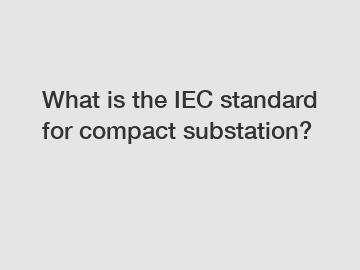What is the IEC standard for compact substation?
With competitive price and timely delivery, BOKR sincerely hope to be your supplier and partner.
What is the IEC standard for compact substation?
In today's fast-paced world, the demand for efficient and reliable electrical infrastructure is greater than ever. One key component of a modern electrical system is the compact substation, which plays a crucial role in the distribution and transmission of power. But what exactly is the IEC standard for compact substations, and why is it important?

1. What is the IEC standard for compact substation?
The International Electrotechnical Commission (IEC) is a global organization that sets standards for a wide range of electrical devices and systems, including compact substations. The IEC standard for compact substations, known as IEC 62271-202, outlines the requirements for the design, construction, and testing of these vital components of an electrical network. These standards ensure that compact substations are safe, reliable, and efficient in their operation.
2. Why is the IEC standard important?
Adhering to the IEC standard for compact substations is essential for several reasons. First and foremost, it ensures the safety of workers and the general public by providing guidelines for the design and installation of these critical components. By following these standards, manufacturers can minimize the risk of electrical faults and other potential hazards.
Additionally, the IEC standard helps to promote interoperability between different brands and models of compact substations. This ensures that components from various manufacturers can work together seamlessly, improving the overall reliability and performance of the electrical system.
3. What are the key requirements of the IEC standard?
The IEC 62271-202 standard covers a wide range of requirements for compact substations, including:
- Design and construction: The standard specifies the materials, dimensions, and layout of compact substations to ensure they meet the required performance and safety standards.
- Electrical characteristics: The standard outlines the necessary electrical ratings, insulation levels, and protection requirements for compact substations to ensure they can handle the expected load conditions.
- Testing and verification: The standard includes procedures for testing and verifying the performance of compact substations before they are put into service, ensuring they meet the necessary specifications and requirements.
4. How do manufacturers comply with the IEC standard?
To ensure compliance with the IEC standard for compact substations, manufacturers must follow a rigorous process of design, testing, and certification. This involves rigorous testing of components and assemblies to ensure they meet the required performance and safety standards as outlined in the standard.
Manufacturers must also maintain detailed documentation of the design, construction, and testing of compact substations to demonstrate compliance with the IEC standard. This documentation is essential for obtaining certification from regulatory authorities and ensuring the quality and reliability of the finished product.
In conclusion, the IEC standard for compact substations is essential for ensuring the safety, reliability, and performance of electrical infrastructure. By adhering to these standards, manufacturers can design and build compact substations that meet the necessary requirements for a modern electrical system. Compliance with the IEC standard helps to promote interoperability, improve safety, and ensure the overall quality of compact substations.
Please visit our website for more information on this topic.
Are you interested in learning more about electrical switchgear manufacturers? Contact us today to secure an expert consultation!



